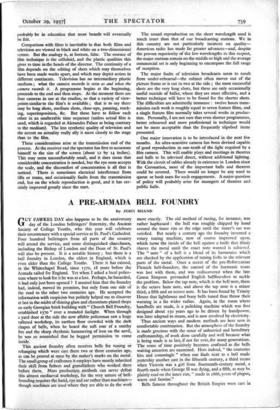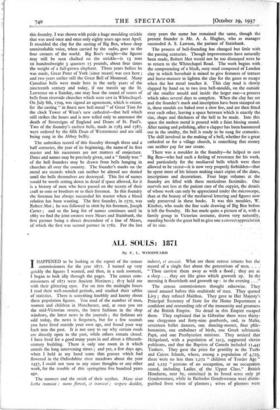A PRE-ARMADA BELL FOUNDRY
By JOHN SHAND
GUY FAWKES DAY also happens to be the anniversary day of the London bellringers' fraternity, the Ancient Society of College Youths, who this year will celebrate their tercentenary with a special service at St. Paul's Cathedral. Four hundred bellringers from all parts of the country will attend the service, and some distinguished churchmen, including the Bishop of London and the Dean of St. Paul's will also be present. It is a notable history ; but there is a bell foundry in London, the oldest in England, which is even older than the College Youths. There it has existed, in the Whitechapel Road, since 1570, 18 years before the Armada sailed for England. Yet when I asked a local police- man where to look for it he was at a loss. Perhaps, he hazarded, it had only just been opened ? I assured him that the foundry had, indeed, moved its premises, but only from one side of the road to the other two centuries ago. He accepted the information with suspicion but politely helped me to discover at last in the midst of shining glass and chromium-plated shops an early Georgian brick building with " Church Bell Foundry, established 1570 " over a rounded fanlight. When through a yard door at the side the now affable policeman saw a huge raftered workshop, its earthen floor crowded with the dark shapes of bells, when he heard the soft roar of a smithy fire and the sharp rhythmic hammering of iron on the anvil, he was so astonished that he begged permission to come inside.
This ancient foundry often receives bells for tuning or rehanging which were cast there two or three centuries ago, as can be proved at once by the maker's marks on the metal. The small group of craftsmen it employs have mostly inherited their skill from fathers and grandfathers who worked there before them. Mass production methods can never defeat this almost mediaeval workshop, for the very nature of bell- founding requires the hand, eye and ear rather than machines— though machines are used where they are able to do the work more exactly. The old method of tuning, for instance, was rather haphazard : the bell was roughly chipped by hand around the inner rim or the edge until the tuner's ear was satisfied. But nearly a century ago the foundry invented a rotary tuning machine, now of course improved upon, which turns the inside of the bell against a knife that thinly shaves the metal until the exact note wanted is achieved. The " note " of a bell is a blend of its harmonics which are checked by the application of tuning forks to the relevant parts of the metal. Once a secret of the pre-Reformation Flemish bell-founders, the control of the harmonic tones was lost with them, and was rediscovered when the late Canon Simpson persuaded English bellfounders to tackle the problem. Below the tap note, which is the bell note, there is the octave hum note, and above the tap note is a minor third, a fifth and an octave note. It has been found by Trinity House that lighthouse and buoy bells tuned thus throw their warning in a far wider radius. Again, in the room where handbells are made, is a polishing machine which was first designed about 15o years ago to be driven by handpower, was later adapted to steam, and is now revolved by electricity.
Thus ancient ways and modern methods arc here seen in comfortable combination. But the atmosphere of the foundry is made gracious with the sense of unhurried and hereditary craftsmanship, of work done carefully and well because what is being made is to last, if not for ever, for many generations. The sense of time positively becomes confused as the bells waiting attention are examined. Here indeed, " the centuries kiss and commingle " when one finds next to a bell made yesterday another cast in the fifteenth century, a third recast when Victoria was a girl from fourteenth-century metal, a fourth made when George II was dying, and a fifth, as may be plainly read on the inner rim, " made in 1666, ycere of plague, warre and famine."
Bells famous throughout the British Empire were cast in this foundry. I was shown with pride a huge moulding strickle that was used once and once only eighty years ago next April. It moulded the clay for the casting of Big Ben, whose deep unmistakable voice, when carried by the radio, goes to the four corners of the world. Big Ben's weight—the figures' may still be seen chalked on the strickle—is 13 tons xo hundredweight 3 quarters 75 pounds, about four times the weight of a full-grown elephant. Three years before he was made, Great Peter of York (since recast) was cast here ; and two years earlier still the Great Bell of Montreal. Many Canadian bells were made here in the early years of the nineteenth century and today, if one travels up the St. Lawrence on a Sunday, one may hear the sound of scores of bells from riverside churches which were cast in Whitechapel. On July 8th, 1709, was signed an agreement, which is extant, for the casting " in finest new bell metal " of Great Tom for the clock Tower of Wren's new cathedral—that bell which still strikes the hours and is now tolled only to announce the death of Sovereigns of England and Deans of St. Paul's. Two of the foundry's earliest bells, made in 1583 and 1587, were ordered by the fifth Dean of Westminster and are still being rung in the Abbey belfry.
The unbroken record of this foundry through three and a half centuries, the year of its beginning, the name of its first master and his successors are not matters of conjecture. Dates and names may be precisely given, and a " family tree " of the bell founders may be drawn from bells hanging in churches all over the country. The founder's marks on the metal are records which can neither be altered nor denied until the bells themselves are destroyed. This list of names would be worth setting down in detail if space allowed, for it is a history of men who have passed on the secrets of their craft to sons or brothers or to their foremen. In this foundry the foreman has always succeeded his master when a blood relation has been wanting. The first founder, in 1570, was Robert Mot ; he was followed in 1606 by his foreman, Joseph Carter ; and so the long list of names continues until in 1865 we find the joint owners were Mears and Stainbank, the first partner being a direct descendant of a line of Mears, of which the first was second partner in 7782. For the last sixty years the name has remained the same, though the present founder is Mr. A. A. Hughes, who as manager succeeded A. S. Lawson, the partner of Stainbank.
The process of bell-founding has changed but little with the passing centuries. Though improvements have naturally been made, Robert Mot would not be too dismayed ,were he to return to the Whitechapel Road. The work begins with. . the compounding of a black, oozy mud composed of London clay in which horsehair is mixed to give firmness of texture and horse-manure to lighten the clay for the gases to escape when the hot metal touches it. This clay mud is slowly slapped by hand on. to two iron bell-moulds, on the outside of the smaller mould. and inside the larger one—a process which takes several days to complete. When the clay_has set and the founder's mark and inscription have been stamped on it, these moulds are baked over a slow fire, and are then fitted over each other, leaving a space between' which is exactly the size, shape and thickness of the bell to be made. Into this space the molten metal is poured with a faint hissing sound. After tuning and polishing, after a clapper has been hammered out in the smithy, the bell is ready to be rung for centuries. The skill involved in the making of a bell, whether for a great. cathedral or for a village church, is something that money can neither pay for nor create.
There was a moulder in the foundry—he helped to cast Big Ben—who had such a feeling of reverence for his work, and particularly for the mediaeval bells which were then allowed to be recast—it is now very properly forbidden—that he spent most of his leisure making exact copies of the dates, inscriptions and decorations. Four large volumes at the foundry are filled with these meticulous facsimiles. One . marvels not less at the patient care of the copyist, the details. of whose work can only be appreciated under the microscope, than at the beauty of the mediaeval lettering and figures now only preserved in these books. It was this moulder, W. Kimber, who made the fine scale drawing of Big Ben before it left the foundry. He has made quite a picture of it, with a family group in Victorian costume, drawn very naturally, standing beside the great bell to give one a correct appreciation. of its size.



























































 Previous page
Previous page